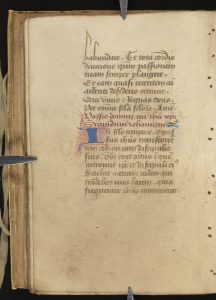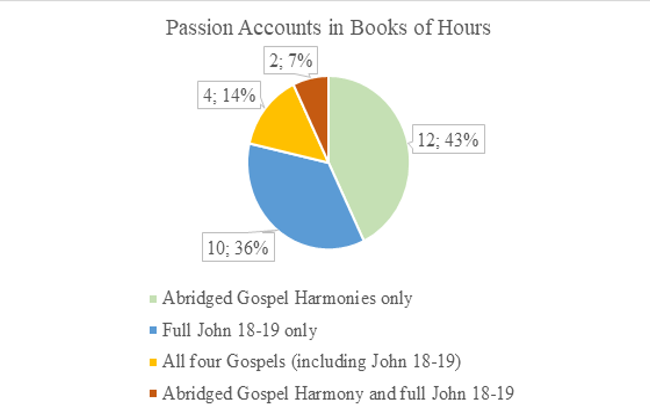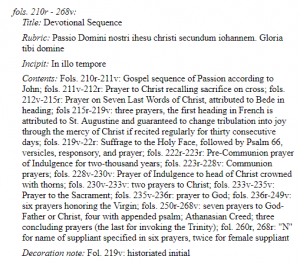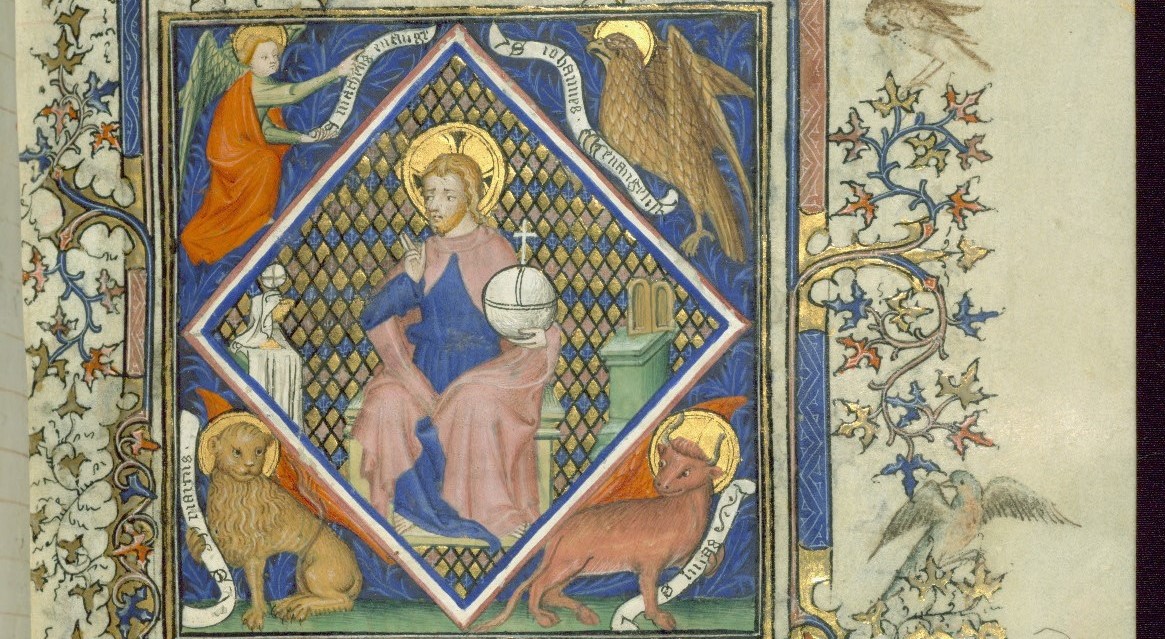Co-authored by Kristina Going and Katherine Haire with Kara Krewer and Ceciley Pangburn
As young, naive English majors fresh from our codicology lessons, we approached the Hargrett Hours Gospel section ready to put our new skills to the test. We rolled up our sleeves, put on our reading glasses, and dove in, expecting to observe and record the similarities between the Hargrett Hours and the other manuscripts on our docket, expecting to find minor variations, if any, on the Gospel of John. Unbeknownst to us, a monster lay in wait, disguised as John’s account of the Passion: the Frankengospel.

In our research into the Hargrett Hours, we decided to research manuscripts that have the Passion according to John and are available in digital facsimile. Twenty-eight manuscripts from a list of 217 (provided to us by Katie Lech and Madison Hogan) fit this criteria. We honestly didn’t know what we’d find and drudged through the briar patches of many a lettre bâtarde script comparing these manuscripts’ Passion sequences to the Hargrett itself. Along the way, we stumbled on something that we just couldn’t seem to shake. Some manuscript descriptions called the accounts they contain “abridged.” These were compelling to us, and we felt a little bit of dread not knowing what this could mean. Before we knew it, we were entangled in a research project that reached far outside the confines of the Hargrett Hours.
Once we sorted the manuscripts based on their Passion sequence, we were shocked to learn that these “abridged” accounts were far greater in number than we initially thought. The Hargrett Hours itself contains the full John 18-19 account that barely varies from the Latin Vulgate, if at all. In total, sixteen of the twenty-eight included the full John 18-19 account. Fourteen of the total are these abridged accounts, with some overlap with the full John 18-19, meaning that some of the manuscripts have both the abridged and full accounts (see Figure 1: Appearances of John’s Passion Accounts in Books of Hours).

Figure 1: Appearances of John’s Passion Account in Books of Hours
Dread creeped up our spines at the complex turn our research had taken, but soon lightning stuck and sparked a revelation in our quest for answers about these abridged Passion accounts. These abridged accounts, varying considerably from the John account, are samplings of different parts of the four Gospels. You get the head and torso from John here, the arms and legs from Matthew there, the feet and hands from Luke, and maybe a toe from Mark. Interestingly enough, they all follow a similar format, with the same insertions of verses in the same places. For instance, they open with John 19:1-3 then break into Matthew 27:30 before returning to John 19:16b-18, and this sampling goes on (for the exact format, see Figure 2: Verses Chart).

Several notable Frankengospels include London, British Library, Kings MS 9, Utah State, De Villers Book of Hours, COLL V BOOK 360, and Baltimore, Walters Art Gallery MS W.197. The manuscript descriptions for the Frankengospels, as seen in these examples, often states that the Gospel sequence is from John, indicating that cataloguers probably simply read the first and last lines of the sequence to see where it begins and ends, and did not read the content as thoroughly as our group tasked ourselves to do.
At this point, we were thrilled to discover that the Frankengospels were influenced by the tradition of Gospel harmonies. In the high and late Middle Ages, there was a renewed interest in the Gospel harmonies that led to a desire for a more comprehensive text that contained all of the detail from the Gospels in one place (Pitts 1; De Lang 37-38). These harmonies were meant to render a deeper understanding of the biblical text (including the Passion narrative) for readers, as they were “intended for meditative or contemplative use” (De Lang 38). The fourteen Gospel harmonies in the Books of Hours that we examined were static in format (meaning they had the same verses in the same places as discussed above), and the verses seemed to flow well into one another to create a single voice.
The Gospel harmonies were usually created to present the entire Passion narrative as fully and concisely as possible. Weirdly, though, the author of the Frankengospels cut out so much of the Gospels as they spliced together the story, contributing to our grotesque desire to call them “Frankengospels” (Katie Lech and Mikaela LaFave’s “Franken-prayers” was also a delightful inspiration). While in some parts they actively seek to create a thorough account by grafting details from Matthew, Mark, and Luke onto John’s skeleton, they cut most of the account down to only include specific episodes.
Like warped plastic surgeons, the authors of the Frankengospels cherry-picked the portions of the Passion they wanted to include in order to best serve their purpose. The authors only select passages from John 19, excluding much of the action that takes place in John 18 leading up to the Crucifixion. What remains of John 19 focuses on the physical aspects of the Passion, such as the torture and suffering Jesus endures before and along the route to Golgotha and while on the Cross, while the additions from other Gospels highlight the miraculous events of the Passion. This abridged Gospel harmony highlight Christ’s suffering, vividly depicting Christ’s flagellation (John 19:1-3), and adding details in which the torment and ridicule is furthered as Christ is beaten and spit on by Pilate’s soldiers (Matthew 27:30). The narrative does not then explore the political aspects of the Crucifixion as Pilate and the Jews wrestle with the nature of Christ’s punishment; rather, it immediately cuts to the Crucifixion scene with Christ on the cross (John 19:16b-18).
The most important omission occurs at the cross, with the removal of all mention of Mary. This is extremely unusual, especially considering that Books of Hours are particularly Marian focused — the defining text in all Books of Hours are the Hours to the Virgin (Weick 60; Reinburg 209). In assessing why the John account was so popular in Books of Hours, we discovered that it is the only Gospel account which mentions the Virgin Mary at the Cross. Mary’s presence allowed the reader a more intimate understanding of the emotional cost of Christ’s loss, providing the reader with an example for their own emotional response to the text. The Frankengospels, despite being built on the foundation of John’s Gospel, carve away their most distinguishing feature.
| Verse | Summary |
| John 19: 1-3 | Christ is flogged, receives the Crown of Thorns and purple robe and is beaten and ridiculed. |
| Matthew 27: 30 | Christ is spit on and beaten. |
| John 19: 16b-18 | Christ is taken to Golgotha and crucified with two criminals |
| John 19: 28-30 | Christ is given wine to drink from a sponge, after which he bows his head and passes away. |
| Matthew 27: 51-52 | Series of miracles (some concurrent with Luke): the temple veil tears in two, earthquake, and the dead are raised. |
| Luke 23:45 | Series of miracles (some concurrent with Matthew): solar eclipse and the temple veil tears in two. |
| Matthew 27:54; Mark 15:39 | The centurian sees the miracles and believes that He was the Son of God. |
| John 19: 34-35 | The soldier pierces Christ’s side; blood and water flow out of the wound; those who saw it believed that Christ was telling the truth. |
Figure 2: Most common way of Abridging John’s Passion account; referred to as abridged Gospel harmonies.
At this point, we decided to ask two questions: why would users of Books of Hours decide to commission a Frankengospel over the full account, and why would the Frankengospels remove Mary, the emotional heart of, and our eyes in, the Passion (Reinburg 221-222)? Once we created a summary of the verses and realized that the Frankengospels focus largely on the physical torment of Christ, we began to understand why. It all seemed to lead back to the idea of the Gospel harmony.
We found that as early as the second century, the differences between the Gospels were thought to be problematic, so the harmony was the answer (De Lang 37). Gospel harmonies, “mosaics of the New Testament Gospels,” were of great interest, so much so that they vied for the attention of the average medieval Christian, who had a choice of whether to commission the abridged or the full account in their Book of Hours (Pitts 1). This may be why we see a nearly even split between the number of Frankengospels and the full John 18-19 accounts within our pool of data.
The original attempt to compile all four Gospels into one account, Tatian of Mesopotamia’s Diatessaron in the latter half of the second century, was lost, but others attempted to do the same. A French scholar from around the time of production for some of our manuscripts, Jean Gerson, engaged with the Gospel harmony tradition by issuing his own harmony, the Monotessaron, in 1420 (De Lang 37). Unlike Tatian who attempted to make his harmony an “apostolic” account, Gerson made his for comparative study, as he believed that the Gospels are the foundations of theology (38, 39). The Monotessaron shares some of the harmony pattern and logistical details as the Frankengospels, but unfortunately not all. While it is currently not clear how (or whether) Gerson influenced the fourteen Frankengospels (some of which were produced before or around the time of his Monotessaron), his own harmony indicated to us that there was interest in the harmony proper, especially in France and the Netherlands in the time and place that many of our manuscripts came from.
Mary’s removal from the Gospel harmony appears initially to be just a result of the format. A creator of Gospel harmonies, such as Gerson, “typically removes repetitions, smooths contradictions, and recasts shared episodes,” making it “richer and more detailed” that the original text (Pitts 1). Still, why remove Mary since she provides an emotional center? Wouldn’t this make the harmony “richer?” We decided to dig deeper into potential reasons for her omission. While there are no definitive answers, there are several possibilities that we speculated upon. The first is that the removal of Mary also eliminates the physical presence of John the Evangelist because he appears in the same verses and is an important figure in those verses. The second is to keep the Passion account focused on Jesus’ suffering and his miracles.
John’s removal allows for the Gospel harmony to truly be a mixing of all four Gospels into one. He was an eyewitness of the Passion, so his account is important and may be the closest we can get to what actually happened, as recorded by tradition (Hazard 10-11). Logically then, if John stays a part of the harmony, he sticks out in a couple of ways. His presence both takes away from Jesus’ Passion as well as lends focus to one of the Evangelists above the others. While the Frankengospels rely heavily on John, they are not solely composed of his work, and this is important in keeping the integrity of the harmonization.
After Christ’s death, the Frankengospels insert a series of miracles, extracted and formed into a composite list from those mentioned in Matthew and Luke before concluding with a miracle from John’s account. The additions from Matthew and Luke are all distinctly separate from Christ and perceived as supernatural occurrences (Matthew 27: 51-52; Luke 23:45). These insertions assert the power of Christ and his relationship to the miraculous, which was missing from John’s account. The miracles are clearly related to Christ’s death because one of the miracles takes place in his physical body; the Frankengospels all conclude with the soldiers piercing Christ’s side and water and blood flowing from the wound. All of the power is thus emanating from Christ himself and the sacrifice made. These details may be lost or not as easily connected when they are not read in close proximity to one another, as they are when simply reading all of the distinct Gospel Passion accounts individually.
The Frankengospels never did what we expected. At every turn, we were surprised by what they chose to include and what they so brutally axed. The Frankengospel’s synthesis of the four Gospels creates a strangely poignant text; although we ultimately determined that the full Gospel of John account is more emotionally stressing than the abridged form, the abridged form still deals out emotional blows with pinpoint accuracy, the force amplified by the narrow focus of the text on the physicality of the Passion. This hybrid that we found lurking, wearing the deceptive skin of John’s Gospel, turned out to be a remarkable and surprising demonstration of medieval authors’ conscious choice to construct the most passionately affective text as possible. In our tireless research into the Frankengospels, the lesson we learned was that everything is not always as it seems; sometimes the most interesting clue is right under your nose, waiting for someone to stumble upon it.
Works Cited
De Lang, Marijke H. “Jean Gerson’s Harmony of the Gospels (1420).” Nederlands archief voor kerkgeschiendenis / Dutch Review of Church History, vol. 71, no. 1, Brill, 1991, pp. 37-49. JSTOR, www.jstor.org/stable/24009392. Accessed 28 November 2018.
Hazard, Mark. The Literal Sense and the Gospel of John in Late Medieval Commentary and Literature, Routledge, 2002. ProQuest Ebook Central, http://ebookcentral.proquest.com.proxy-remote.galib.uga.edu/lib/ugalib/detail.action?docID=1581750.
Pitts, Brent A. The Anglo-Norman Gospel Harmony: A translation of the Estoire de l’Evangile (Dublin, Christ Church Cathedral C6.1.1, Liber niger), Arizona Center for Medieval and Renaissance Studies, 2014.
Reinburg, Virginia. French Books of Hours: Making an Archive of Prayer, c.1400-1600. Cambridge UP, 2012.Wieck, Roger. Time Sanctified: The Book of Hours in Medieval Art and Life. George Braziller, 2001.
